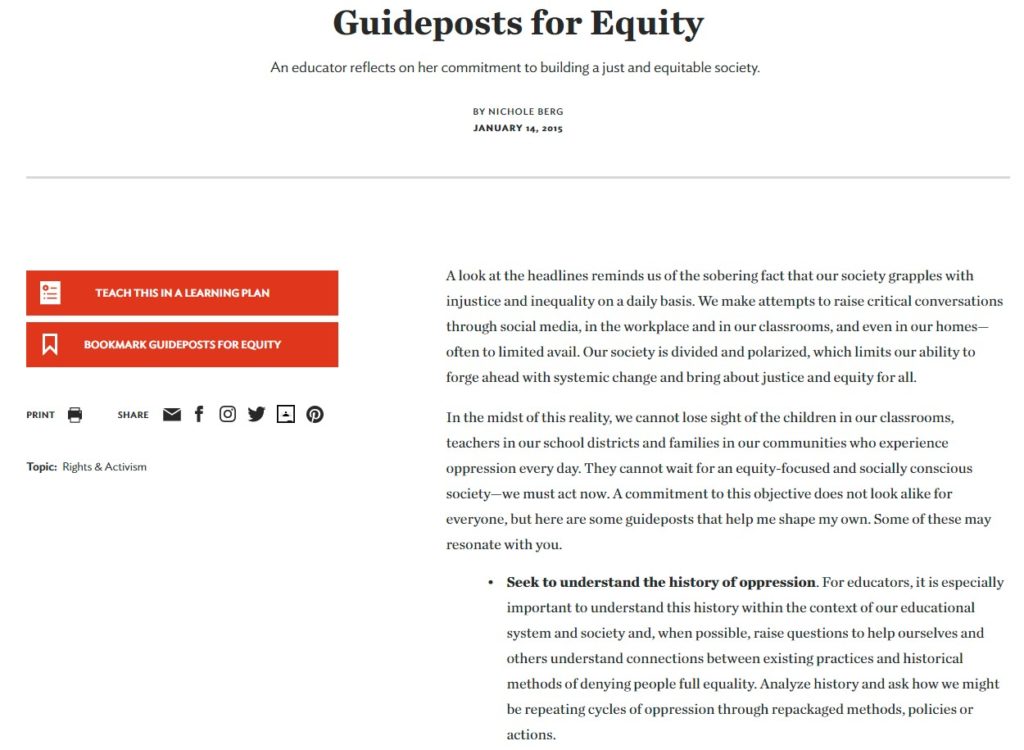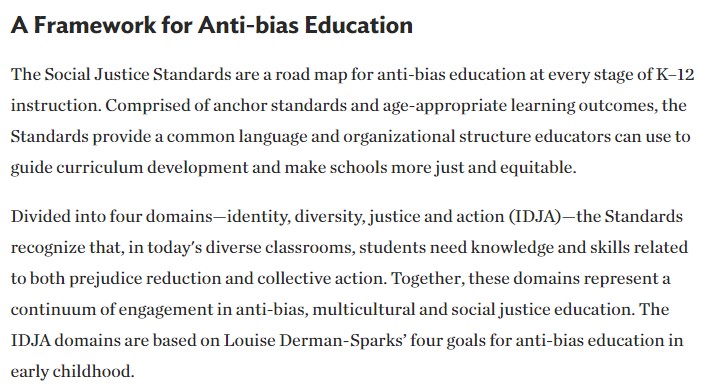
Rawlinson Road Middle School teacher has students read by “Stamped”; school district promotes racial affinity groups and mandatory equity training for educators
Incidents
FITSNews reported that a Rawlinson Road Middle School teacher had students in seventh grade read the book Stamped: Racism, Anti-Racism, and You by political activists Jason Reynolds and Ibram X. Kendi. The book is known to promote racial equity as a way to deal with perceived oppression. The news outlet then quoted Ibram X. Kendi as previously stating: “The only remedy to past discrimination is present discrimination. The only remedy to present discrimination is future discrimination.”
Rawlinson Road Middle School’s district – Rock Hill Schools – appeared to previously have an “Equity Committee.” The school district has a page on its website labeled “Equity Committee” that is now blank.

The district has two documents on its website promoting “Diversity, Equity and Inclusion Consulting Services.” The first document appeared to be created for a “Pre-Proposal Meeting.” Goals of this meeting included an “intent to award” a contract and a “contract implementation.”
The second document appeared to be created for “Questions and Answers” about a “Cultural Competence Strategic Framework.” In order to implement this project, the document ensures that data on “parents/families,” “student discipline/identification/placement,” “staff and students (from cultural climate surveys),” and “student achievement data” will be used. A “DEI task force” will also “provide support, resources, and approval of study functions” to conduct a “research study.” However, the document also explains that “the Consultant is expected to lead data collection, analysis, and benchmarking functions.”
The document includes a section called “Our Cultural Competence Commitment” that states it is submitted by the “Rock Hill Schools Diversity, Equity, and Inclusion Task Force.” The commitment states that “healing is a slow process that begins with a single step acknowledging the hurt felt by those in need of care.” The commitment then states:
Established in July of 2020 by Dr. William Cook, Jr. the Diversity, Equity, and Inclusion (DEI) Task Force reflects our dedication to doing the work needed to sustain and advance cultural competence within our organization. With the purpose of ensuring our shared values remain at the forefront of our efforts, this body serves to assess, implement, and evaluate evidence-based practices governing the services we provide to the community. The team fulfills this service by researching inclusive practices, supporting district leadership in identifying and addressing structural inequities, and celebrating diversity in every aspect of our organization.
The commitment also has a “Social Identity Characteristics” diagram that features “Rock Hill Schools” in the center with extensions to the phrases “race and ethnicity,” “gender,” “religion,” “age,” “ability and disability,” “sexual orientation,” “socio-economic status,” and “language, culture, and immigration status.” The commitment also contains six objectives to achieve:
- Partner with the larger community to advance voice and representation on matters of diversity, equity, and inclusion.
- Facilitate an equity audit to identify factors impacting student and team member success.
- Provide consultation to district leaders on diversity, equity, and inclusion matters.
- Submit recommendations for objectives, action steps, resources, learning experiences, and program evaluation methods for inclusion in system decision-making processes.
- Support district leaders in communicating evidence of progress on DEI objectives.
- Integrate the Inclusion Compass model within district decision-making processes.
The commitment then reiterates the school district’s policy on “nondiscrimination” and “equal opportunity” that was adopted in June 2019. This policy specifically mentions “gender identity” and “sexual orientation.”
The commitment also states the school district’s “beliefs.” One belief is that “all students, regardless of their unique circumstances and learning styles, can learn within equitable and culturally responsive learning environments.” The term “culturally responsive” is often used to describe a method of teaching that includes the race and ethnicity of students as part of the lessons taught in classrooms. The commitment also lists a “Diversity, Equity, and Inclusion” objective as aiding the “administration in being proactive in planning for solutions to problems, engage student committees (student council, SIC, diversity clubs) at each school in gathering feedback on school DEI issues by June 2022.”
The school district intends to additionally focus on staff with mandatory training in diversity and equity. The commitment also states that the school district will create at least three “affinity groups” to address the issue of “inclusion and retention.” The commitment later explains that affinity groups “are composed of employees who share an identity characteristic.” Affinity groups are essentially segregated groups that separate staff on the basis of identity traits such as race and sexual orientation. In the commitment’s objectives for “recruitment and retention” of staff, the following objectives are provided:
- By October 2021, each school and division will include 3-5 hours of DEI training into annual professional learning plans.
- By October 2021, provide support, training, and guidance for the ongoing implementation of equitable hiring practices.
- By June 2022, each certified employee will include and complete DEI professional learning experiences through the ADEPT/PADEPP Professional Growth and Development Plan.
- By June 2022, Teacher Cadet programs will increase recruitment efforts addressing children in poverty and students of color by 50%.
- By June 2022, the HR Division will increase support for alternative certification initiatives by 50%.
- By July 2022, the HR Division will direct no less than three affinity groups addressing work group inclusion and retention.
The commitment also lists objectives for the school district to ensure “student achievement.” The first objective is to implement resources for the previously mentioned “8 identity groups” that include “race and ethnicity,” “gender,” “religion,” “age,” “ability and disability,” “sexual orientation,” “socio-economic status,” and “language, culture, and immigration status.” The commitment lists the following four objectives:
- By December 2022, Library/Media Centers in all schools Pre-K-12 will include resources representative of the 8 identity groups.
- By June 2022, all instructional coaches, specialists, and school-based teacher leaders will engage in training on culturally responsive teaching.
- By June 2022, job-embedded professional learning experiences targeting diversity, equity, and inclusion will increase by 50%.
- By June 2022, instructional leaders will develop an action plan for responding to disparities in Gifted and Talented services.
The commitment ends with a “Glossary of Terms.” The document describes an “ally” as “a person who is not an identifying member of a group, but supports the equitable treatment of those who identify as members of a particular group.” The document then describes “LGBTQI” as “individuals and/or the community of persons who identify as Lesbian, Gay, Bisexual, Transgender, Queer, or Intersex.”
In the references for the commitment, the school district lists the “Guideposts for Equity” page from the organization Learning for Justice. The “Guideposts for Equity” page on the Learning for Justice’s website explains that “we cannot lose sight of the children in our classrooms, teachers in our school districts and families in our communities who experience oppression every day.” The organization then states that “they cannot wait for an equity-focused and socially conscious society—we must act now.” This page encourages educators to “seek to understand the history of oppression.”

Learning for Justice is an organization known for pushing its “Social Justice Standards” to be adopted in schools throughout the country. The document for these standards includes goals to achieve for students. One goal is that “students will develop language and historical and cultural knowledge that affirm and accurately describe their membership in multiple identity groups.” Another goal appears to outright state that the purpose of the “Social Justice Standards” is to turn students into political activists: “Students will make principled decisions about when and how to take a stand against bias and injustice in their everyday lives and will do so despite negative peer or group pressure.”

Stay Informed
